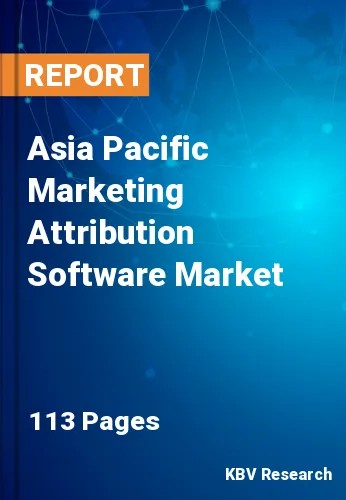The Asia Pacific Marketing Attribution Software Market would witness market growth of 14.6% CAGR during the forecast period (2022-2028).
The data collection is kept separate from the rest of the company, making it far more difficult to apply to upcoming campaigns for optimization. But, as marketing attribution shifts to multi-touch models, firms must now measure marketing touches that happen with current contacts. These contacts aren't new leads, but they're also not prospects because a sales team has already been allocated to them, even though they haven't made a purchase yet.
In an advanced multi-touch approach, the company is assessing marketing's influence on a prospect more so than "sourcing." The issue here is that historically, sales teams have only been interested in hearing about what has been sourced, not about marketing's impact on prospects that they are actively chasing. As a result, marketing is making an ongoing effort to persuade sales that the greatest influence marketing can have on the organization is more than simply pure lead-based demand generation — it's about strategically collaborating with sales to mature and close deals faster than ever.
The "cloud-first" strategy is especially visible as the Digital India strategy expands. The project will transfer existing on-premises and legacy systems to a cloud-based or unified architecture. In addition, this project would result in the nationwide deployment of cloud-based digital marketing tools. Companies from underdeveloped nations are increasingly expanding their activities onto the world stage with the assistance of investors seeking to speed their expansion. Hence, the expanding use of digital marketing tools drives the Asia-Pacific market for marketing attribution software.
The China market dominated the Asia Pacific Marketing Attribution Software Market by Country in 2021, and would continue to be a dominant market till 2028; thereby, achieving a market value of $615.8 million by 2028. The Japan market is estimated to grow a CAGR of 13.9% during (2022 - 2028). Additionally, The India market would experience a CAGR of 15.3% during (2022 - 2028).
Based on Component, the market is segmented into Solution and Services. Based on Type, the market is segmented into Multi-source Attribution, Probabilistic or Algorithmic Attribution and Single-source Attribution. Based on Deployment Mode, the market is segmented into On-premises and Cloud. Based on Organization Size, the market is segmented into Large Enterprises and Small & Medium Enterprises (SMEs). Based on Vertical, the market is segmented into Consumer Goods & Retail, BFSI, Telecom & IT, Healthcare, Travel & Hospitality, Media & Entertainment and Others. Based on countries, the market is segmented into China, Japan, India, South Korea, Singapore, Malaysia, and Rest of Asia Pacific.
Free Valuable Insights: The Worldwide Marketing Attribution Software Market is Projected to reach USD 7.2 Billion by 2028, at a CAGR of 13.7%
The market research report covers the analysis of key stake holders of the market. Key companies profiled in the report include Oracle Corporation, Google LLC (Alphabet, Inc.), SAP SE, Adobe, Inc., Merkle Inc. (Dentsu Group Inc.), Neustar, Inc. (TransUnion LLC), HubSpot, Inc., Nielsen Holdings plc (Elliott Investment Management L.P.), Ruler Analytics Limited, and Windsor Group AG
By Component
By Type
By Deployment Mode
By Organization Size
By Vertical
By Country
Our team of dedicated experts can provide you with attractive expansion opportunities for your business.

